
Midnight Family 2019
Distributed by Passion River Films, 154 Mt. Bethel Rd., Warren, NJ 07059; 732-321-0711
Produced by Kellen Quinn and Luke Lorentzen
Directed by Luke Lorentzen
Streaming, 81 mins
High School - General Adult
Communication; Medicine; Transportation
Date Entered: 08/21/2020
Reviewed by Kimberly Poppiti, St. Joseph's College, Patchogue, NYMidnight Family is a feature-length documentary set in Mexico City where, as viewers learn, a population of 9 million people is served by less than 45 government-operated emergency ambulances. The slack in emergency health care is picked up by independent, for-profit, private ambulances, including one operated by the Ochoa family, who are the main subjects of this film.
Director Luke Lorentzen opens Midnight Family from the perspective of one inside the ambulance, looking out the back windows. This opening shot sets the tone for the active viewing experience to come throughout the film, which unfolds mainly through footage of Fer, Juan, and Josue Ochoa at work, with glimpses into their personal lives. The film’s premise and characters are fascinating, and Lorentzen’s direction and cinematography suit the content perfectly, allowing the action to unfold in what feels like real-time, with viewers riding along with the Ochoas as they work.
The work of the Ochoa family is captivating and, as depicted in the film, alternates between a few activities. A good portion of the family’s work time is spent simply waiting for the next emergency call to come in. This time is devoted to a range of activities, including simple necessities, such as napping or eating; other times, the Ochoas talk amongst themselves or over the phone with friends, sometimes describing details of ambulance calls that were not shown on camera. When a call does come in, the family springs into action, racing other private ambulances at breakneck speed through crowded streets, with lights flashing and sirens blaring, and often while shouting over their speakers for other motorists or pedestrians to move out of their way, in the hopes of arriving first at the incident scene. Once on the scene, the family provides emergency medical intervention and transportation, as well as emotional support, for passengers with devastating and sometimes life-threatening injuries. Finally, once patients are delivered to hospitals and turned over to doctors for emergency care, the Ochoas try (often unsuccessfully) to convince their passengers, or their passenger’s families, to pay them for the services they have provided.
Viewers of Midnight Family learn that the successful operation of a private ambulance in Mexico City is challenging and uncertain. It requires not only the stabilization and transportation of often critically injured patients, but also adherence to an array of guidelines and benchmarks governing the operation of private ambulances, (with some requirements apparently exceeding the standard for government-run ambulances). For success, the proprietors of private ambulances need a strong work ethic, along with strong communication and social skills, which enable them to navigate a complex network of information, as well as the requisite chain of paybacks due to those allowing them to operate, and providing them with information enabling them to arrive first on accident scenes, ahead of other private ambulances, and to gain the necessary clearance to proceed to hospitals.
Midnight Family is a captivating and well-made film. It provides viewers with the opportunity to experience a unique world, filled with high-stakes decisions, fast-paced action, and engaging characters. Potential viewers should note that the film includes graphic, although not gratuitous, descriptions and images of serious injuries; people transported by the Ochoas include victims of a car accident, domestic violence, a gunshot wound, and a four-story fall. Not all of the victims survive.
Midnight Family is presented in Spanish, with English subtitles. It is suitable for audiences of high school age and older. The film is likely to be of greatest interest to those in the fields of Communication, including Interpersonal Communication and Family Relations, Medicine, and Transportation.
Awards:
Documentaire Extraordinaire (Bergen International Film Festival, 2019); US Documentary Special Jury Award for Cinematography (Sundance Film Festival); Best Editing (IDA Documentary Awards); Grand Jury Award Winner (Sheffield Doc Fest, 2019); Golden Frog (Camera Image, 2019); Best of Fest, Grand Jury Prize (Gimli Film Festival, 2019); Best Documentary Feature, Best Mexican Long Feature Film, & Best Director (Guadalajara International Film Festival, 2019); Best Mexican Documentary Feature (Guanajuato International Film Festival, 2019); Golden Firebird Award, Documentary (Hong Kong International Film Festival, 2019); Best Editing (International Documentary Association, 2019); Best Film, International Federation of Cinema Societies’ Prize, & Russian Press Prize (St. Petersburg Message to Man Film Festival, 2019)